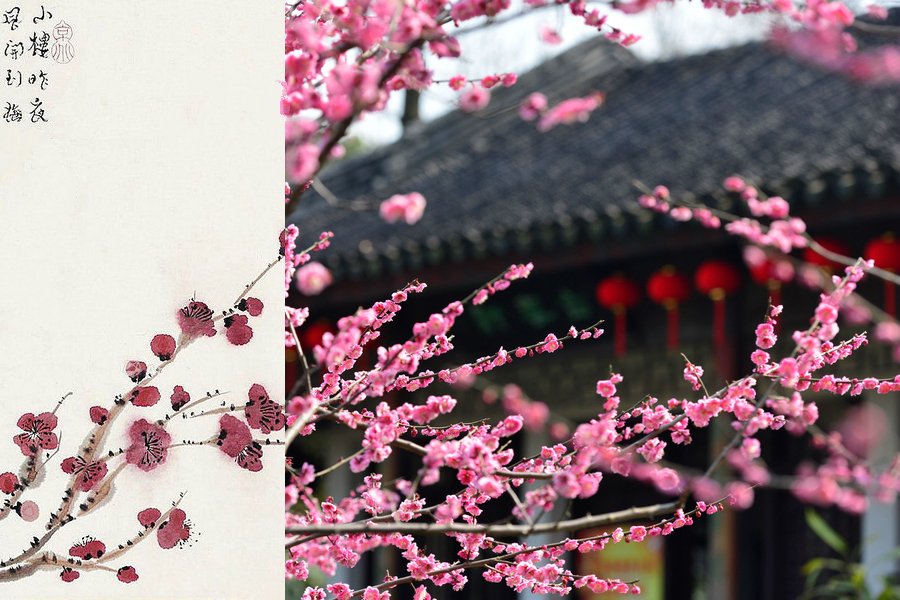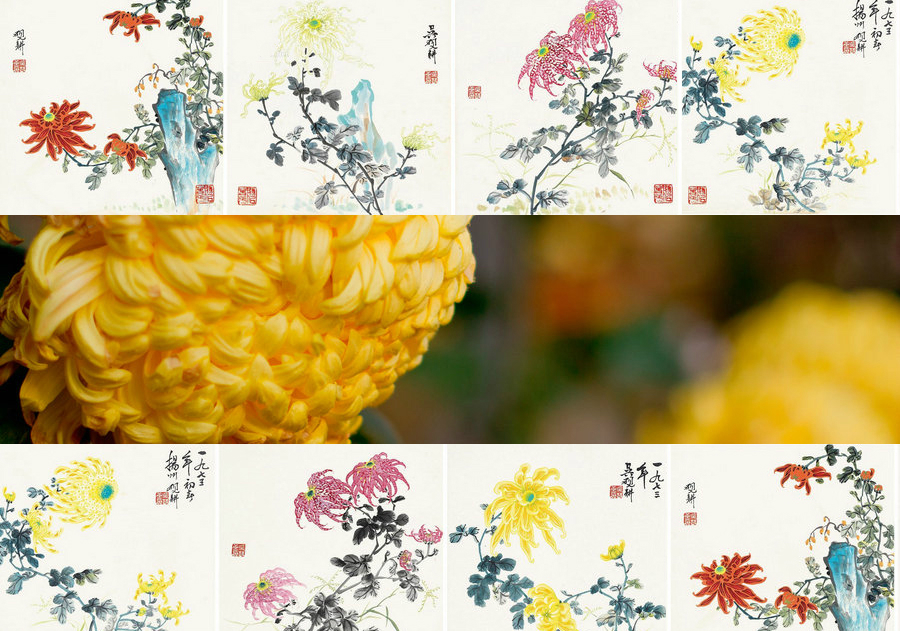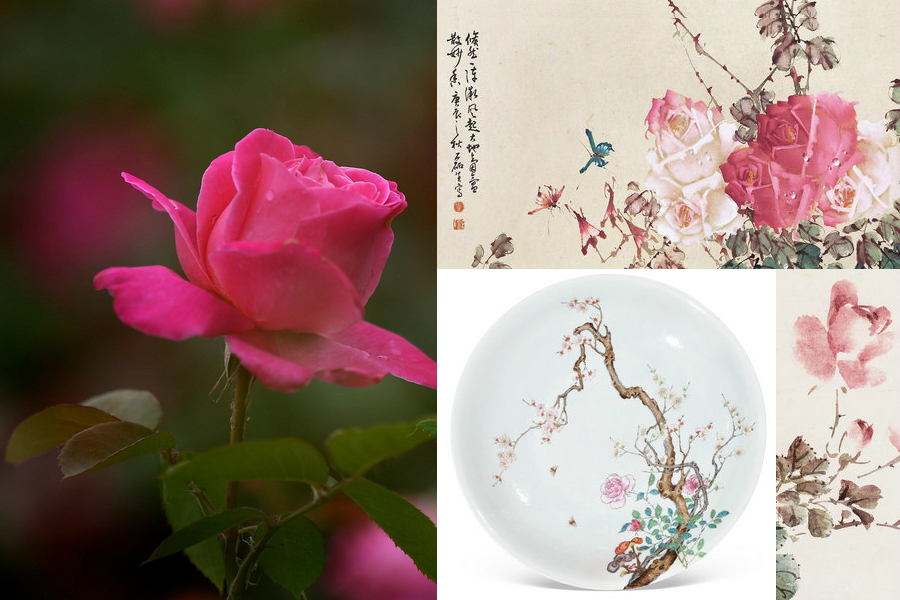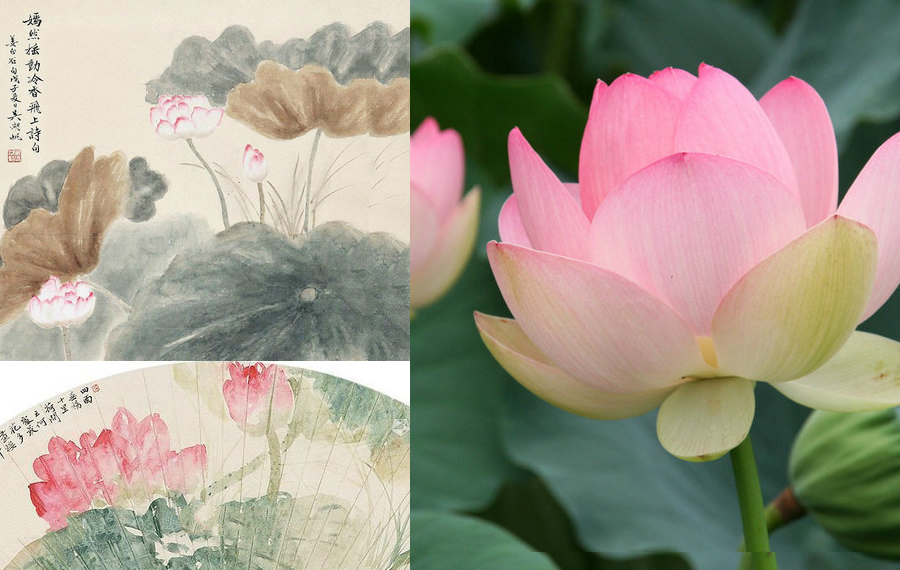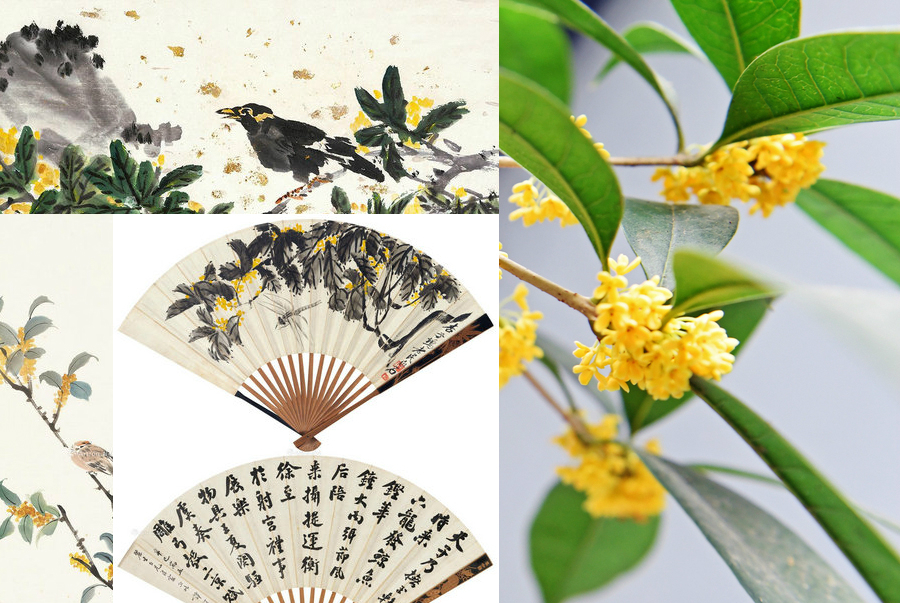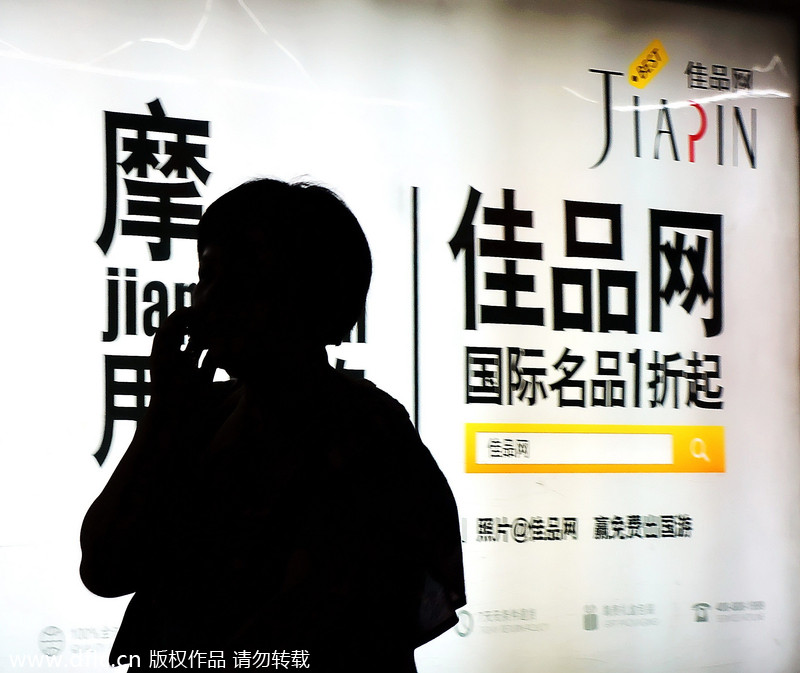Poetic beauty: 10 most significant flowers in China
By Li Hongrui | chinadaily.com.cn | 2017-03-01

Messengers of spring, embodiments of beauty, flowers are one of the most amazing wonders on this planet. They appear in literature, food, beverages and decorations that adorn us.
As a new year starts and spring draws nearer day by day, we can look forward to another round of flowers blooming in the following months.
We've highlighted 10 of the most well-known flowers in China that have special significance in Chinese culture.
Plum blossom and a Chinese ink painting of plum blossom. [Photo/VCG; artron.net]
Plum blossom
In Mao Zedong's poem
Ode to Plum Blossom, he described the flower like this: "Fair and beautiful. Not craving for spring for her own, only to tell the coming of the season. When all flowers bloom in full, she smiles among them. "
Mao used the plum blossom as a metaphor to praise great martyrs who sacrificed their lives for a better life for Chinese people.
In traditional Chinese culture, plum blossom stands for noble, unsullied and modest qualities. Along with orchid, bamboo and chrysanthemum, they are praised as the "Four Men of Noble Character".
Plum blossom cake is one the most famous snacks in Nanjing, Suzhou and Wuxi. Made in the shape of plum blossom, the cake is made of sticky rice, jam, nuts and red bean paste.
Click here to listen to a Chinese folk song about plum blossom:
Plum Blossom Snow
Penoy and a Chinese fan painted with a peony. [Photo/VCG]
Peony
The great Chinese poet Li Bai, from the Tang Dynasty (AD 618-907), once compared concubine Yang Yuhuan's beautiful face to blooming peonies in his famous poem
Qing Ping Diao. "Floating clouds remind me of her clothes, and peonies her face," he wrote.
Flowering in May, peonies' large petals and strong colors are linked to prosperity and richness in traditional Chinese culture. Thus, it became very popular during the Tang Dynasty, a period of time when Chinese people preferred magnificent and glorious things, such as fat and strong horses and large flowers. In the late Qing Dynasty, the peony was chosen as the national flower.
In many New Year pictures, fairy children always hold peonies that bear people's wishes for an auspicious and rich new year.
Dried peony petals can also be added in tea and traditional Chinese medicine to alleviate pain caused by menstruation.
Click here to listen to a Chinese folk song about peonies:
Song of Peony
Chrysanthemum and Chinese ink paintings of the flower. [Photo/VCG; artron.net]
Chrysanthemum
This flower is often associated with famous poet Tao Yuanming from the Eastern Jin Dynasty (AD 317-420). In his poem
Drinking Wine, Tao wrote: "While picking up chrysanthemums beneath the eastern fence, my gaze was leisurely upon the southern mountains". The piece became one of the most well-known poems, picturing a peaceful and satisfying life dreamed of by many people.
Tao was a recluse who enjoyed the beauty of nature and a simple life. The chrysanthemums he referenced came to symbolize humility, rather than seeking fame and wealth.
With its unsophisticated beauty, chrysanthemum is also a symbol of longevity in Chinese myths and literature.
According to traditional Chinese medicine theory, chrysanthemum tea can relieve internal heat and fever. That's why people often drink the tea after having too much spicy and baked food. Pillows made of dried chrysanthemum are also good for people's eyes.
Click here to listen to Jay Zhou's song about chrysanthemum:
Ju Hua Tai
Chinese rose, ink paintings of the flower and a plate painted with Chinese roses from the Qing Dynasty. [Photo/VCG; artron.net]
Chinese rose
Bearing a strong resemblance to other roses, yet with fewer thorns and larger petals, the plant originates from China, hence the name "Chinese rose".
"Bloom or fade, the flower never cares about arrival of spring; Best peonies only appear in late spring and early summer, yet Chinese roses enjoy the four seasons with unceasing beauty," poet Su Shi from the Song Dynasties ( 960-1279) described the flower in his poem.
Chinese people started to grow the rose about 2,000 years ago. In the Han Dynasty (206 BC- AD 220), Chinese roses were widely grown in royal gardens. And in the Tang Dynasty, the flowers found their way into most regions along the Yangtze River.
Apart from being extracted to make perfume, the roots, leaves and flowers of Chinese roses are used in traditional Chinese medicine to cure menstruation disorders.
Click here to listen to Enya Brennan's:
Chinese Roses
Azalea and Chinese ink paintings of the flower. [Photo/VCG; artron.net]
Azalea
Often appearing in old Chinese poems and stories, azalea, or
du juan, is the favorite flower of poet Bai Juyi from the Tang Dynasty. He not only praised the flowers in his poems, but tried to grow azaleas.
"Once grown on hills, now blooming in gardens…send a message to God and let azalea be the king of flowers," Bai wrote in his poem
Azalea Twelve Tunes.
In Chinese mytholgy, a melancholy bird named
Du Juan bleated day and night until it spat blood, which painted all the flowers on the hill red. The flowers were named after the miserable bird.
The whole plant can be used in traditional Chinese medicine and can help to cure kidney illness and deafness.
Click here to listen to a song related to azalea:
Du Juan
Lotus and Chinese ink paintings of the flower. [Photo/VCG; artron.net]
Lotus
Lotus flower is an important symbol of pureness in Buddhism, and also traditional Chinese culture. A Song Dynasty scholar, Zhou Dunyi, praised lotus as "unsullied from silt where it comes from, retains demure despite being cleaned by water" in his prose
Ai Lian Shuo.
In ancient Chinese literature, the lotus is often connected with women's noble and pure personality. In the Chinese classic
The Dream of the Red Chamber, Qing Wen, an honest and upright maid of protagonist Jia Baoyu, becomes a lotus fairy after passing away.
The flower, along with its leaves, seeds and roots have being widely used in both Chinese cuisine and traditional Chinese medicine for thousands of years.
Click here to listen to a Zen-style song:
Lian Xin Qu
Camellia and Chinese ink paintings of the flower. [Photo/VCG; artron.net]
Camellia
Coco Chanel's favorite flower, the camellia, has been planted in China as early as the Three Kingdoms (AD 220-280).
There is a poem
Ode to Camellia, written by a lady called "Madame Huarui", that describes the camellia as "Blooming on the hills, like burning sunset glow and floating pink clouds…the scenery is more beautiful than hundreds of flowers blooming in heaven."
According to medical doctor Li Shizhen's
Ben Cao Gang Mu, a scientific medical text with details of more than 1,800 drugs from Chinese medicine, 1,100 illustrations and 11,000 prescriptions, the flower can be used to cure fire burn and empyrosis.
Click here to listen to a popular song:
Send You a Camellia
Sweet-scented osmanthus and Chinese ink paintings of the flower. [Photo/VCG; artron.net]
Sweet-scented osmanthus
In her poem, Li Qingzhao from the Song Dynasty, described osmanthus as "light yellow, with a soft body, only leave fragrant smell behind. light yellow, with a delicate figure, that only leaves fragrance behind; No need for bright greens and reds, the osmanthus is a flower destined to shine."
Planting sweet-scented osmanthus in China has a history of more than 2,500 years. Often blooming in August, the plant is also connected with Mid-Autumn Festival due to the fairy tale about a man named Wu Gang. Wu is ordered to cut down a large and strong osmanthus tree on the moon every day, yet the charmed tree never falls and has fragrant flowers each autumn. Wu is only allowed to have a rest for Mid-Autumn Festival.
The little yellow flowers are often added to porridge, cakes and tea to enhance the taste. In Guangxi province where many osmanthus trees are planted, the perfume produced by the flowers has become an important local specialty.
Click here to listen to a Chinese folk song:
Fragrant Osmanthus in Jiangnan
Narcissus and Chinese ink paintings of the flower. [Photo/VCG; artron.net]
Narcissus
With its green, white and yellow colors, narcissus, often grown in water, bears a kind of heavenly beauty. Thus it always finds its way into mythologies from different cultures.
In Greek mythology, the flower was named after a hunter Narcissus who was well-known for his beauty. And in Chinese folklore, narcissus is the embodiment of Emperor Yao's two daughters, E Huang and Nv Ying.
Zhu Xi, a leading Confucian scholar of the School of Principle from the Song Dynasty, described narcissus as "a fairy with yellow hats and green sleeves".
According to historical records, the original narcissus was imported from Italy in the Tang Dynasty. Chinese people cultivated better flowers after centuries of breeding. In China, narcissus can be sculptured into various kinds of bonsais. The flowers are often used as a decoration during the Chinese New Year.
Click her to listen to Teresa Teng's:
Little Narcissus

Orchid and Chinese ink paintings of the flower. [Photo/VCG; artron.net]
Orchid
As one of the "Four Men of Noble Character" in Chinese culture, the orchid is better known for its delicate fragrance. And its Chinese character "
lan" has being widely used in women's names for thousands of years.
Ancient Chinese called eternal friendship "
lan jiao", or companionship as nobel as the orchid, and beautiful prose and poems "
lan zhang", or words as graceful as the orchid. People started to grow the flower in China about 2,000 years ago. After the Wei and Jin dynasties (AD 220- 420), orchids were mainly used to decorate gardens.
The first monograph on orchids in the world,
Jin Zhang Lan Pu, was written by Zhao Shigeng from the Song Dynasty. With a total of three volumes, the book recorded about 30 kinds of orchids and their living habits.
Click here to listen to Yanni's:
With an Orchid























